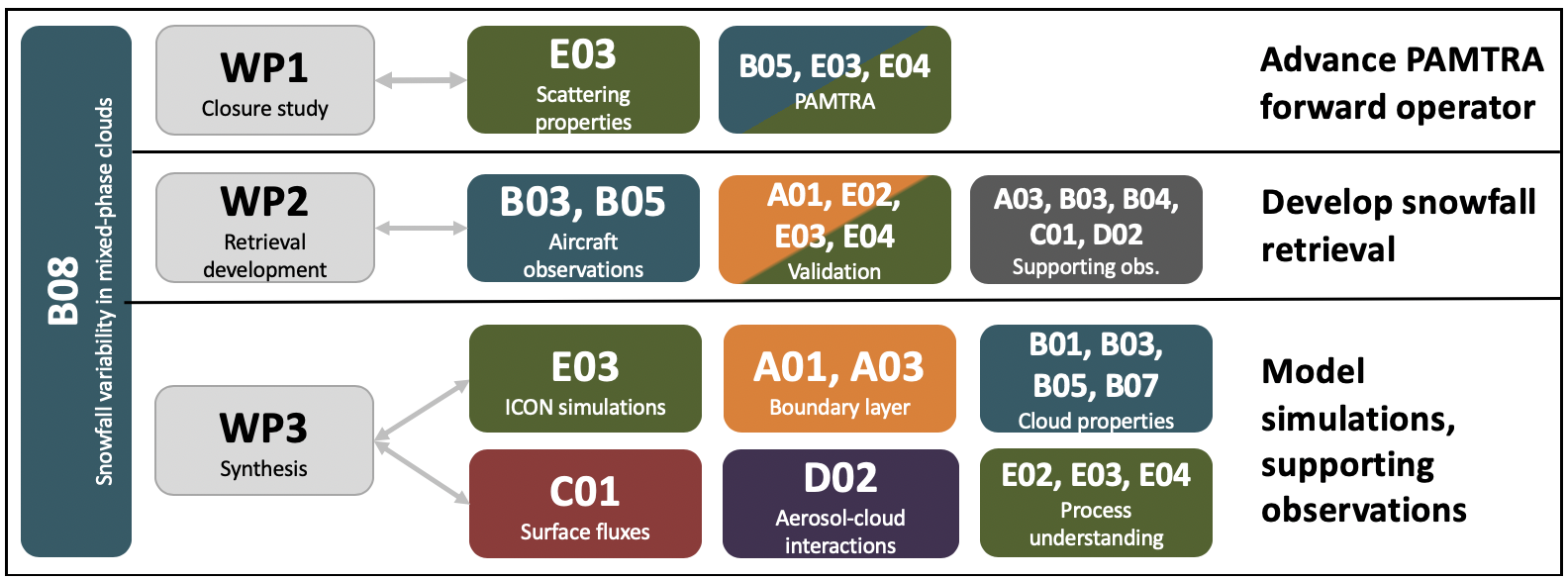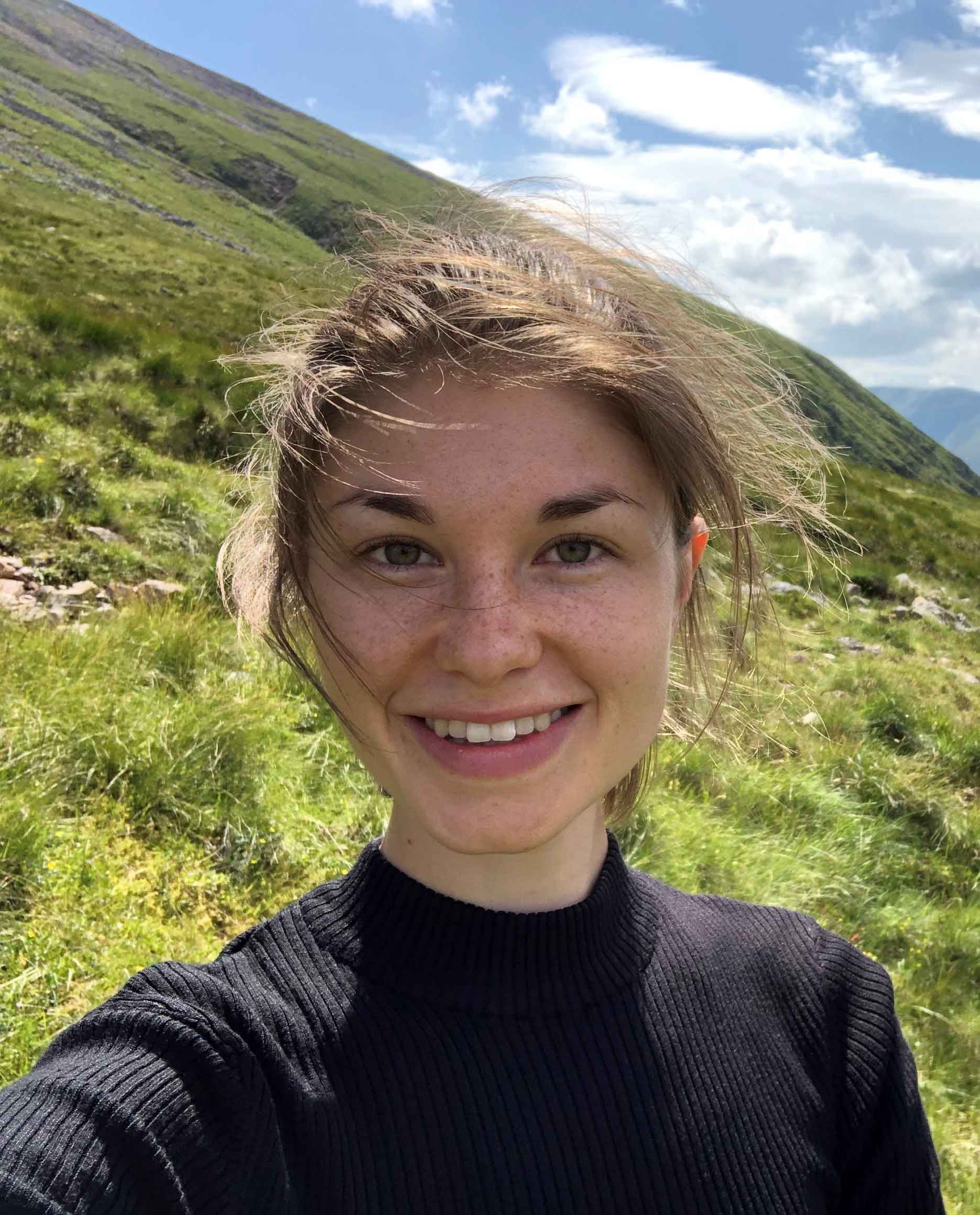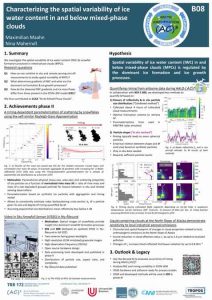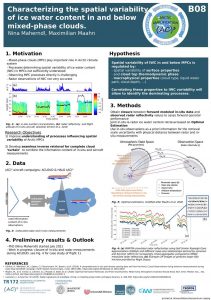B08: Characterising the spatial variability of ice water content in and below mixed-phase clouds
PROJECT ENDED IN 2023
PIs: Maximilian Maahn
B08 is a project that was funded later than the other (AC)³ phase II projects and started in July 2021. The goal of B08 was to investigate the spatial variability of ice water content (IWC) and the corresponding snowfall formation processes in mixed-phase clouds (MPCs) based on the (AC)³ airborne campaigns. The PL Maximilian Maahn and PhD student Nina Maherndl participated in the HALO-(AC)³ field experiment that took part in March and April 2022 and operated remote sensing instruments on board the research aircraft Polar 5. Maximilian Maahn acted as mission principle investigator (PI) for research flight 5 of Polar 5 on March 28. Within the B08 project, we were particularly interested in joint flights of Polar 5 and Polar 6 to obtain spatially and temporally collocated radar and in–situ measurements of clouds. This flight strategy was successfully implemented in five flights, collecting about four hours of collocated in cloud measurements. Further, B08 set up and operated together with E02 a 2nd generation Video In Situ Snowfall Sensor (VISSS) in Ny–Ålesund. The main scientific results of phase II are presented below.
Hypothesis:
Spatial variability of ice water content (IWC) in and below MPCs is regulated by the spatial variability of surface properties and cloud top thermodynamic phase in addition to macrophysical properties such as cloud type, liquid water path, cloud depth, moisture availability and surface coupling. Correlating these properties to IWC variability will allow to identify the dominating processes.
In testing the hypothesis, we address the following overarching questions:
- How can we combine in situ and remote sensing aircraft measurements to obtain spatial variability of IWC in and below clouds with minimal uncertainties?
- What determines the vertical and horizontal gradients of IWC in the Arctic atmosphere and how do these gradients differ depending on the observed dominant ice formation processes and boundary conditions such as surface fluxes, cloud phase variability at cloud top or liquid water path?
- How do the observed IWC gradients and ice mass fluxes differ from those present in the ICON-LEM model for similar cloud types and forcing?
Role within (AC)³
Members
Nina Maherndl
PhD
University of Leipzig
Leipzig Institute for Meteorology (LIM)
Stephanstr. 3
04103 Leipzig
Dr. Maximilian Maahn
Principal Investigator
University of Leipzig
Leipzig Institute for Meteorology (LIM)
Stephanstr. 3
04103 Leipzig
Publications
2024
Maahn, M., Moisseev, D., Steinke, I., Maherndl, N., and Shupe, M. D., 2024: Introducing the Video In Situ Snowfall Sensor (VISSS), Atmos. Meas. Tech., 17, 899–919, https://doi.org/10.5194/amt-17-899-2024.
2023
Maherndl, N., Moser, M., Lucke, J., Mech, M., Risse, N., Schirmacher, I., and Maahn, M., 2023: Quantifying riming from airborne data during HALO-(AC)3, EGUsphere, https://doi.org/10.5194/egusphere-2023-1118, [preprint].
Maherndl, N., Maahn, M., Tridon, F., and Dupuy, R., 2022: Retrieving riming in arctic mixed phase clouds from collocated remote sensing and in situ aircraft measurements during ACLOUD , EGU General Assembly 2022, Vienna, Austria, 23–27 May 2022, EGU22-13359, https://doi.org/10.5194/egusphere-egu22-13359.
Maherndl, N.; Maahn, M.; Tridon, F.; Leinonen, J.; Ori, D. & Kneifel, S., 2023: Data set of simulated rimed aggregates for “A riming-dependent parameterization of scattering by snowflakes using the self-similar Rayleigh-Gans approximation”, Zenodo, https://doi.org/10.5281/zenodo.7757034
Maherndl, N.; Maahn, M.; Moser, M.; Lucke, J.; Mech, M. & Risse, N., 2023: Airborne observations of riming in arctic mixed-phase clouds during HALO-(AC)3, EGU General Assembly 2023, 24–28 Apr 2023, EGU23-5000, https://doi.org/10.5194/egusphere-egu23-5000
Maherndl, N.; Maahn, M.; Tridon, F.; Leinonen, J.; Ori, D. & Kneifel, S., 2023: A riming-dependent parameterization of scattering by snowflakes using the self-similar Rayleigh–Gans approximation, Q.J.R. Meteorol. Soc., 149(757), 3562–3581, https://doi.org/10.1002/qj.4573
Maahn, M., 2023: Video In Situ Snowfall Sensor (VISSS) data processing library V2023.1.6, Zenodo, https://doi.org/10.5281/zenodo.7650394
Maahn, M., 2023: Video In Situ Snowfall Sensor (VISSS) data acquisition software V0.3.1, Zenodo, https://doi.org/10.5281/zenodo.7640801
Maahn, M.; Haseneder-Lind, R. & Krobot, P., 2023: Hardware Design of the Video In Situ Snowfall Sensor v2 (VISSS2), Zenodo, https://doi.org/10.5281/zenodo.7640821
Wendisch, M.; Brückner, M.; Crewell, S.; Ehrlich, A.; Notholt, J.; Lüpkes, C.; Macke, A.; Burrows, J. P.; Rinke, A.; Quaas, J.; Maturilli, M.; Schemann, V.; Shupe, M. D.; Akansu, E. F.; Barrientos-Velasco, C.; Bärfuss, K.; Blechschmidt, A.-M.; Block, K.; Bougoudis, I.; Bozem, H.; Böckmann, C.; Bracher, A.; Bresson, H.; Bretschneider, L.; Buschmann, M.; Chechin, D. G.; Chylik, J.; Dahlke, S.; Deneke, H.; Dethloff, K.; Donth, T.; Dorn, W.; Dupuy, R.; Ebell, K.; Egerer, U.; Engelmann, R.; Eppers, O.; Gerdes, R.; Gierens, R.; Gorodetskaya, I. V.; Gottschalk, M.; Griesche, H.; Gryanik, V. M.; Handorf, D.; Harm-Altstädter, B.; Hartmann, J.; Hartmann, M.; Heinold, B.; Herber, A.; Herrmann, H.; Heygster, G.; Höschel, I.; Hofmann, Z.; Hölemann, J.; Hünerbein, A.; Jafariserajehlou, S.; Jäkel, E.; Jacobi, C.; Janout, M.; Jansen, F.; Jourdan, O.; Jurányi, Z.; Kalesse-Los, H.; Kanzow, T.; Käthner, R.; Kliesch, L. L.; Klingebiel, M.; Knudsen, E. M.; Kovács, T.; Körtke, W.; Krampe, D.; Kretzschmar, J.; Kreyling, D.; Kulla, B.; Kunkel, D.; Lampert, A.; Lauer, M.; Lelli, L.; von Lerber, A.; Linke, O.; Löhnert, U.; Lonardi, M.; Losa, S. N.; Losch, M.; Maahn, M.; Mech, M.; Mei, L.; Mertes, S.; Metzner, E.; Mewes, D.; Michaelis, J.; Mioche, G.; Moser, M.; Nakoudi, K.; Neggers, R.; Neuber, R.; Nomokonova, T.; Oelker, J.; Papakonstantinou-Presvelou, I.; Pätzold, F.; Pefanis, V.; Pohl, C.; van Pinxteren, M.; Radovan, A.; Rhein, M.; Rex, M.; Richter, A.; Risse, N.; Ritter, C.; Rostosky, P.; Rozanov, V. V.; Donoso, E. R.; Saavedra-Garfias, P.; Salzmann, M.; Schacht, J.; Schäfer, M.; Schneider, J.; Schnierstein, N.; Seifert, P.; Seo, S.; Siebert, H.; Soppa, M. A.; Spreen, G.; Stachlewska, I. S.; Stapf, J.; Stratmann, F.; Tegen, I.; Viceto, C.; Voigt, C.; Vountas, M.; Walbröl, A.; Walter, M.; Wehner, B.; Wex, H.; Willmes, S.; Zanatta, M. & Zeppenfeld, S., 2023: Atmospheric and Surface Processes, and Feedback Mechanisms Determining Arctic Amplification: A Review of First Results and Prospects of the (AC)³ Project, Bull. Am. Meteorol. Soc., American Meteorological Society, 104, E208–E242, https://doi.org/10.1175/bams-d-21-0218.1
2022
Maahn, M., Goren, T., Shupe, M. D., and de Boer, G., 2021. Liquid containing clouds at the North Slope of Alaska demonstrate sensitivity to local industrial aerosol emissions. Geophys. Res. Lett., 48, e2021GL094307. https://doi.org/10.1029/2021GL094307





